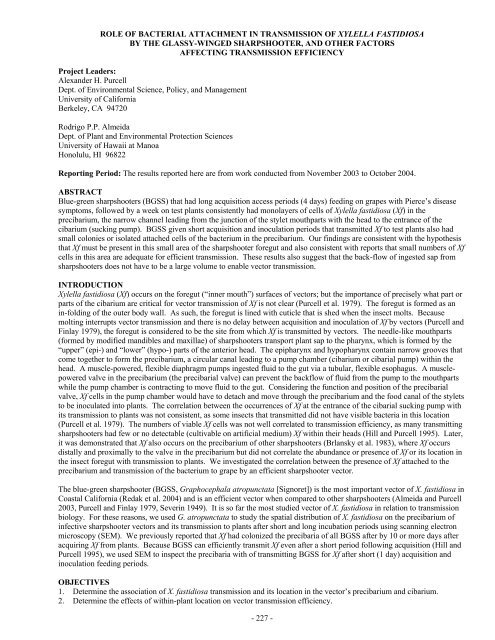Impact Of Host Plant Xylem Fluid On Xylella Fastidiosa Multiplication ...
Impact Of Host Plant Xylem Fluid On Xylella Fastidiosa Multiplication ...
Impact Of Host Plant Xylem Fluid On Xylella Fastidiosa Multiplication ...
Create successful ePaper yourself
Turn your PDF publications into a flip-book with our unique Google optimized e-Paper software.
ROLE OF BACTERIAL ATTACHMENT IN TRANSMISSION OF XYLELLA FASTIDIOSA<br />
BY THE GLASSY-WINGED SHARPSHOOTER, AND OTHER FACTORS<br />
AFFECTING TRANSMISSION EFFICIENCY<br />
Project Leaders:<br />
Alexander H. Purcell<br />
Dept. of Environmental Science, Policy, and Management<br />
University of California<br />
Berkeley, CA 94720<br />
Rodrigo P.P. Almeida<br />
Dept. of <strong>Plant</strong> and Environmental Protection Sciences<br />
University of Hawaii at Manoa<br />
Honolulu, HI 96822<br />
Reporting Period: The results reported here are from work conducted from November 2003 to October 2004.<br />
ABSTRACT<br />
Blue-green sharpshooters (BGSS) that had long acquisition access periods (4 days) feeding on grapes with Pierce’s disease<br />
symptoms, followed by a week on test plants consistently had monolayers of cells of <strong>Xylella</strong> fastidiosa (Xf) in the<br />
precibarium, the narrow channel leading from the junction of the stylet mouthparts with the head to the entrance of the<br />
cibarium (sucking pump). BGSS given short acquisition and inoculation periods that transmitted Xf to test plants also had<br />
small colonies or isolated attached cells of the bacterium in the precibarium. Our findings are consistent with the hypothesis<br />
that Xf must be present in this small area of the sharpshooter foregut and also consistent with reports that small numbers of Xf<br />
cells in this area are adequate for efficient transmission. These results also suggest that the back-flow of ingested sap from<br />
sharpshooters does not have to be a large volume to enable vector transmission.<br />
INTRODUCTION<br />
<strong>Xylella</strong> fastidiosa (Xf) occurs on the foregut (“inner mouth”) surfaces of vectors; but the importance of precisely what part or<br />
parts of the cibarium are critical for vector transmission of Xf is not clear (Purcell et al. 1979). The foregut is formed as an<br />
in-folding of the outer body wall. As such, the foregut is lined with cuticle that is shed when the insect molts. Because<br />
molting interrupts vector transmission and there is no delay between acquisition and inoculation of Xf by vectors (Purcell and<br />
Finlay 1979), the foregut is considered to be the site from which Xf is transmitted by vectors. The needle-like mouthparts<br />
(formed by modified mandibles and maxillae) of sharpshooters transport plant sap to the pharynx, which is formed by the<br />
“upper” (epi-) and “lower” (hypo-) parts of the anterior head. The epipharynx and hypopharynx contain narrow grooves that<br />
come together to form the precibarium, a circular canal leading to a pump chamber (cibarium or cibarial pump) within the<br />
head. A muscle-powered, flexible diaphragm pumps ingested fluid to the gut via a tubular, flexible esophagus. A musclepowered<br />
valve in the precibarium (the precibarial valve) can prevent the backflow of fluid from the pump to the mouthparts<br />
while the pump chamber is contracting to move fluid to the gut. Considering the function and position of the precibarial<br />
valve, Xf cells in the pump chamber would have to detach and move through the precibarium and the food canal of the stylets<br />
to be inoculated into plants. The correlation between the occurrences of Xf at the entrance of the cibarial sucking pump with<br />
its transmission to plants was not consistent, as some insects that transmitted did not have visible bacteria in this location<br />
(Purcell et al. 1979). The numbers of viable Xf cells was not well correlated to transmission efficiency, as many transmitting<br />
sharpshooters had few or no detectable (cultivable on artificial medium) Xf within their heads (Hill and Purcell 1995). Later,<br />
it was demonstrated that Xf also occurs on the precibarium of other sharpshooters (Brlansky et al. 1983), where Xf occurs<br />
distally and proximally to the valve in the precibarium but did not correlate the abundance or presence of Xf or its location in<br />
the insect foregut with transmission to plants. We investigated the correlation between the presence of Xf attached to the<br />
precibarium and transmission of the bacterium to grape by an efficient sharpshooter vector.<br />
The blue-green sharpshooter (BGSS, Graphocephala atropunctata [Signoret]) is the most important vector of X. fastidiosa in<br />
Coastal California (Redak et al. 2004) and is an efficient vector when compared to other sharpshooters (Almeida and Purcell<br />
2003, Purcell and Finlay 1979, Severin 1949). It is so far the most studied vector of X. fastidiosa in relation to transmission<br />
biology. For these reasons, we used G. atropunctata to study the spatial distribution of X. fastidiosa on the precibarium of<br />
infective sharpshooter vectors and its transmission to plants after short and long incubation periods using scanning electron<br />
microscopy (SEM). We previously reported that Xf had colonized the precibaria of all BGSS after by 10 or more days after<br />
acquiring Xf from plants. Because BGSS can efficiently transmit Xf even after a short period following acquisition (Hill and<br />
Purcell 1995), we used SEM to inspect the precibaria with of transmitting BGSS for Xf after short (1 day) acquisition and<br />
inoculation feeding periods.<br />
OBJECTIVES<br />
1. Determine the association of X. fastidiosa transmission and its location in the vector’s precibarium and cibarium.<br />
2. Determine the effects of within-plant location on vector transmission efficiency.<br />
- 227 -











